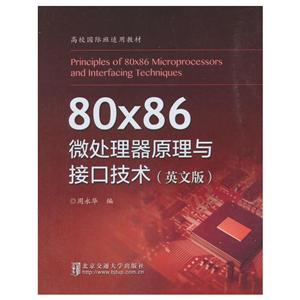扫一扫
关注中图网
官方微博
本类五星书更多>
-
>
决战行测5000题(言语理解与表达)
-
>
软件性能测试.分析与调优实践之路
-
>
第一行代码Android
-
>
深度学习
-
>
Unreal Engine 4蓝图完全学习教程
-
>
深入理解计算机系统-原书第3版
-
>
Word/Excel PPT 2013办公应用从入门到精通-(附赠1DVD.含语音视频教学+办公模板+PDF电子书)
8086微处理器原理与接口技术-(英文版) 版权信息
- ISBN:9787512136458
- 条形码:9787512136458 ; 978-7-5121-3645-8
- 装帧:一般胶版纸
- 册数:暂无
- 重量:暂无
- 所属分类:>
8086微处理器原理与接口技术-(英文版) 内容简介
周永华编的《80×86微处理器原理与接口技术(高校国际班适用教材)(英文版)》深入浅出地介绍Intel 80×86微处理器的工作原理及接口技术知识,探讨基于80×86微处理器的工程系统设计及应用。针对目前国际上相关书籍在接口技术方面介绍比较欠缺的问题,本书致力于系统介绍80×86微处理器的工作原理及接口技术应用。本书内容包括9章,内容包括:微处理器介绍、微处理器架构、指令集、汇编语言编程、存储器、中断、I/O接口技术、A/D和D/A转换、总线接口等。
8086微处理器原理与接口技术-(英文版) 目录
Chapter 1 Introduction to the Microprocessor and Computer
1.1 Microprocessor-based Personal Computer System
1.1.1 Hardware and Software System
1.1.2 Operational Principle
1.1.3 Performance Indexes
1.2 Number System and Codes
1.2.1 Number System
1.2.2 Conversion between Number Systems
1.2.3 Codes
1.3 Representation of the Numbers in the Computer
1.3.1 Fixed Integers
1.3.2 Original Binary Data, Radix-1 Complement and Radix Complement
1.4 Development of Microcomputers
1.4.1 Hardware Advancement
1.4.2 Programming Advancement
1.4.3 Evolution of Microprocessors
1.4.4 Adopted Advanced Technology
1.5 Questions
Chapter 2 The Microprocessors and Architecture
2.1 8086/8088 Microprocessors
2.1.1 Internal Architecture and Operating Modes of 8086/8088 CPU
2.1.2 Pins and the Pin Functions
2.1.3 Internal Registers of Intel Microprocessors
2.1.4 Memory Structure of 8086/8088
2.1.5 Generating Memory Addresses
2.1.6 Bus Timing
2.2 80486 Microprocessor
2.2.1 Internal Structure
2.2.2 Operating Modes
2.2.3 Register and Memory Structure
2.3 Pentium Microprocessor
2.3.1 Internal Structure
2.3.2 Performance Characteristics
2.4 Questions
Chapter 3 Instruction Set
3.1 Addressing Modes
3.2 Instruction Formats of 80x86
3.3 Instruction Set
3.3.1 Data Movement Instructions
3.3.2 Arithmetic Instructions
3.3.3 Logic Instructions
3.3.4 Program Control Instructions
3.4 Questions
Chapter 4 Assembly Language Programming
4.1 Assembly Language Fundamentals
4.1.1 The Format of Assembly Language
4.1.2 Symbols, Data and Expressions of Assembly Language
4.2 Pseudo Instructions
4.2.1 Define Segments
4.2.2 Simplified Pseudo Instructions of Segment Definition
4.2.3 Data Definition Statement
4.2.4 Symbol Definition Statement
4.2.5 Procedure Definition
4.2.6 Some Other Pseudo-instructions
4.3 DOS Functions and BIOS Functions
4.3.1 DOS Functions
4.3.2 BIOS Functions
4.4 Programming
4.4.1 Introduction of Programming
4.4.2 Sequential Structure Program
4.4.3 Branched Program
4.4.4 Loop Program
4.4.5 Subroutines
4.5 Examples of Programming Design
4.6 Introduction to Microsoft Macro Assembler
4.7 Questions
Chapter 5 Memory
5.1 Classification and Performance Indicators of Memory
5.1.1 Classification of Computer Memory
5.1.2 Classification of Semiconductor Memory
5.1.3 Performance Indicators
5.2 ROM
5.2.1 EPROM
5.2.2 EEPROM
5.2.3 Flash
5.2.4 Memory Card
5.3 RAM
5.3.1 SRAM
5.3.2 DRAM
5.3.3 High Speed RAM
5.3.4 Multi-port RAM
5.4 Memory Expansion Design
5.4.1 Basic Structure of the Memory
5.4.2 Memory Expansion Design
5.4.3 Address Decoding
5.4.4 Examples
5.5 Cache
5.5.1 Working Principle
5.5.2 Access Consistency of Cache and Main Memory
5.5.3 Address Mapping of Cache
5.5.4 Replacement Algorithm of Cache
5.6 Virtual Memory
5.7 Questions
Chapter 6 Interrupts
6.1 Overview of Interrupts
6.1.1 Classification of Interrupt Sources
6.1.2 Interrupt Source Priority Arbitration
6.1.3 Interrupt Processing
6.2 80x86 Interrupt System
6.2.1 Interrupt System Structure
6.2.2 Interrupt and Response Process in Real Mode
6.2.3 Store or Get an Interrupt Vector in the Vector Table
6.3 Interrupt Controller 8259A
6.3.1 Structure and Pins of 8259A
6.3.2 Programming 8259A
6.3.3 Examples
6.4 Questions
Chapter 7 I/O Interface Chip 8255A
7.1 I/O Interface Overview
7.1.1 The Structure of I/O Interface
7.1.2 The Functions of I/O Interface
7.1.3 Address Numbering of I/O Ports
7.1.4 Control Approaches of Data Transmissions
7.2 Parallel Interface Chip 8255A
7.2.1 Structure and Pins of 8255A
7.2.2 Operating Modes of 8255A
7.2.3 Programming 8255A
7.2.4 Application of 8255A
7.3 Questions
Chapter 8 Timer/Counter 8254
8.1 Structure and Pins of 8254
8.1.1 Internal Structure
8.1.2 Pins of 8254
8.2 Operating Modes of 8254
8.3 Programming 8254
8.3.1 Control Word
8.3.2 Setting the Initial Count
8.4 Application of 8254
8.5 Questions
Chapter 9 Serial Interface Chip 8250
9.1 Serial Communication Introduction
9.1.1 Modes of Serial Communication
9.1.2 Data Format of Serial Communication
9.1.3 RS-232C Serial Interface Standard
9.2 Structure and Pins of 8250
9.2.1 Internal Structure
9.2.2 Pins of 8250
9.3 Internal Registers of 8250
9.3.1 Line Control Register
9.3.2 Programmable Baud Generator
9.3.3 Line Status Register
9.3.4 Modem Control Register
9.3.5 Modem status register
9.3.6 Interrupt Identification Register
9.3.7 Interrupt Enable Register
9.4 Programming 8250
9.5 Application of 8250
9.6 Questions
Chapter 10 DMA Controller 8237A
10.1 Internal Structure
10.2 Pins of 8237A
10.3 Operating Modes of 8237A
10.4 Timing Diagram of 8237A
10.5 Internal Registers of 8237A
10.6 Programming 8237A
10.7 Examples
10.8 Application of 8237A
10.9 Questions
Chapter 11 A/D and D/A Conversion Interfaces
11.1 A/D and D/A Conversions in Computer Control System
11.2 D/A Conversion and Interface Technology
11.2.1 Principle of D/A Conversion
11.2.2 Typical D/A Converter
11.2.3 Application Examples of D/A Converter
11.3 A/D Conversion and Interface Technology
11.3.1 Principle of A/D Conversion
11.3.2 Typical A/D Converter
11.3.3 Timing Diagram
11.3.4 Application Examples of A/D Converters
11.3.5 Application Issues to Be Noted
11.4 Questions
Chapter 12 Bus Interface
12.1 Overview of the Bus
12.1.1 Classification of the Bus
12.1.2 Main Parameters of Buses
12.2 ISA Bus
12.3 The PCIBus
12.3.1 Introduction of PCI
12.3.2 Signals of the PCI
12.3.3 Subtractive Decode of PCI/ISA Bridge
12.3.4 PCI Bus Operations
12.4 The USB
12.4.1 Introduction of USB
12.4.2 Composition and Principle of USB
12.5 The AGP
12.6 Questions
References
展开全部
书友推荐
- >
巴金-再思录
巴金-再思录
¥14.7¥46.0 - >
烟与镜
烟与镜
¥15.4¥48.0 - >
二体千字文
二体千字文
¥21.6¥40.0 - >
名家带你读鲁迅:朝花夕拾
名家带你读鲁迅:朝花夕拾
¥10.5¥21.0 - >
企鹅口袋书系列·伟大的思想20:论自然选择(英汉双语)
企鹅口袋书系列·伟大的思想20:论自然选择(英汉双语)
¥9.7¥14.0 - >
月亮虎
月亮虎
¥20.2¥48.0 - >
我从未如此眷恋人间
我从未如此眷恋人间
¥15.9¥49.8 - >
有舍有得是人生
有舍有得是人生
¥20.1¥45.0
本类畅销
-
Photoshop 2022中文版案例教程
¥44.1¥59.8 -
局域网组建、管理与维护(第4版)(微课版)
¥47¥59 -
园林AUTOCAD教程
¥24¥45 -
Python实战编程:从零学Python
¥81¥108 -
Java程序设计基础
¥37¥50 -
数据备份与恢复
¥51.4¥69




















